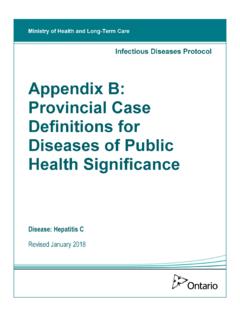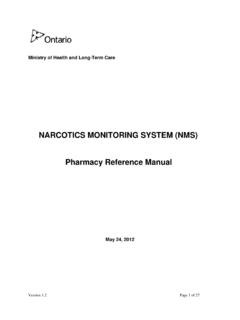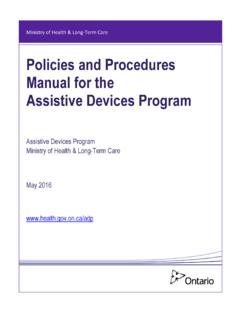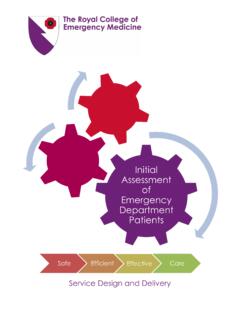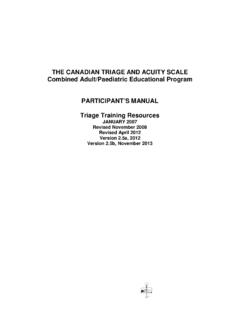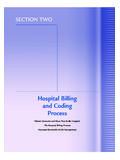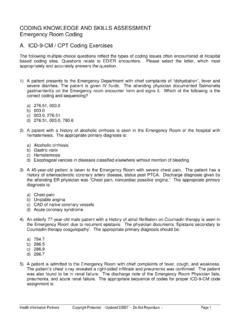Transcription of Improving Access to Emergency Care - Ministry of …
1 O N TA R I OH O S P I TA LA S S O C I AT I O NImproving Access to Emergency care : Addressing System IssuesAugust, 2006 Report of the Physician Hospital care Committee,a Tripartite Committee of theOntario Hospital Association, theOntario Medical Association and theOntario Ministry of Health and Long-Term Careis the first report of the Physician Hospital care Committee,a tripartite committee of theOntario Hospital Association, theOntario Medical Association and theOntario Ministry of Health and Long-Term Committee would like to thank the members of theEmergency department Overcrowding Expert Working Groupfor their valuable advice and Courtyard Group consulting support in developing the reportand Access to Emergency care .
2 Addressing System Issues A committee established by the 2004 Physician ServicesFramework Agreement between the Ontario Medical Associationand the Ontario Ministry of Health and Long-Term N TA R I OH O S P I TA LA S S O C I AT I O NTable of ContentsExecutive Summary1 Consolidated Recommendations4 Foreword12 Chapter 1: An Overview of the Issue13 What is Emergency department Overcrowdingand Why it is a Problem13 The Impact of Population Demographics on Access to Careand Emergency department Overcrowding16 Major Reports Looking at EmergencyDepartment Overcrowding21 What Other Jurisdictions Have Done to RemedyEmergency department Overcrowding25 Chapter 2: Emergency department Overcrowding Data,Performance Targets and Accountability29 Recommended Ontario Performance Targets in Relationto Emergency department Overcrowding29 Relevant Ontario Data32 How is Ontario Doing Right Now?
3 34 Collecting and Using the Data35An Accountability Framework35 Chapter 3:Overcoming the problem of EmergencyDepartment Overcrowding38An Overview of the Causes of Emergency department Overcrowding38 The Mythology of Emergency Room Overcrowding39 Recommended Solutions and a Toolkit for Organizations43 Lack of Bed Availability44 Lack of Integration Between Community and Hospital52 Standards for Emergency Departments57 Suggested Tools to Enhance Emergency department Processes57 Delegation of Controlled Acts59 Implementation of the Recommendations in this Report60 Appendix 1:The Canadian Triage and Acuity Scale61 Appendix 2.
4 Glossary62 Appendix 3: Members of the Emergency DepartmentOvercrowding Expert Working Group63 Improving Access to Emergency care : Addressing System Issues 1 Executive SummaryEmergency department overcrowding has been defined as a situation in which the demand for emergencyservices exceeds the ability of an ( Emergency ) department to provide quality care within acceptable timeframes . Emergency department overcrowding has been a longstanding problem in Ontario; however, thereis compelling evidence that this problem can be solved. The majority of Emergency department waiting forurgent and emergent patients is a result of waiting for an available inpatient bed.
5 Emergency departmentovercrowding is not a problem that has its primary causes concentrated within the Emergency departmentitself; rather it is part of a system-wide problem with Access to care that requires system-wide Ontario s population demographics change, Emergency department overcrowding and its effects willcontinue to escalate. By 2031, approximately 25% of Canada s population will be over the age of 65,almost doubling the current proportion of 13%. Proportionately more patients with complex multi-systemdisease are being seen in Ontario s Emergency departments; the highest visit rate is now in the 75 andolder age group, and this visit rate has increased over 50% since 1992.
6 In order to relieve the burden onemergency departments and the healthcare system as a whole caused by an aging population, it isimperative that Access to care , including Emergency care , be improved. A significant level of coordinationand integration of care between hospital and alternative care settings is required in order to deliver highquality care in the safest and most effective and efficient order to effectively define the extent of delay in Access to Emergency care on a facility-specific, regionalor provincial basis, and in order to effectively evaluate the impact of any interventions to improve Access tocare, an appropriate standard performance target is needed.
7 This target must be easily measurable andreasonably attainable in the current funding climate. It must also be linked to the collection of quality accountability framework should also be established, which is linked to performance in relation to thetargets. This report recommends performance targets together with standardized data elements for overallemergency department length of stay, as well as a performance indicator and standardized data elementsfor a subset of overall length of stay, Emergency department time to admission. The former provides arelevant measure of Access to Emergency care while the latter is more closely linked to the availability, orlack thereof, of acute care capacity and Access to inpatient beds.
8 Success in meeting theseperformance targets must be assessed through incremental improvement in performance ratherthan an expectation that targets will be met soon after they are implemented. To this end, recommendedincremental improvement milestones are provided. At present, the majority of Ontario hospitals are closeto meeting some of the recommended Emergency department length of stay performance targets, and anumber have already surpassed it. Therefore, these are not unrealistic goals. Reliable data are not yetavailable for current hospital performance in relation to Emergency department time to admission and for2 Improving Access to Emergency care : Addressing System Issues this reason the report recommends that data collection in relation to this indicator begin as soon as possibleand that establishment of a target be revisited within one setting of targets and collection of data related to those targets is rendered all the more powerful bylinking them to an accountability framework.
9 This report recommends that the Hospital AccountabilityAgreement framework be used to assess performance and ensure performance improvement in relation toaccess to Emergency care . In addition, an accountability framework for Community care Access Centres,ensuring performance in relation to hospital avoidance, timely discharge from hospital and hospitalsubstitution, is myths exist as to the causes of Emergency department overcrowding, including overuse by non-urgent patients and seasonal outbreaks. The main overarching causes of overcrowding are twofold: a lackof bed availability, and a lack of integration between community and hospital healthcare resources.
10 Thenumber of acute care beds in Ontario fell by 22% during the mid to late 1990s. Acute care bed occupancyrates rose from in 1994/95 to 96% in 2000, and have remained consistently well above 90% sincethen. Occupancy rates above 85% are linked with poor patient flow, including delays in admitting patientsfrom the Emergency department , and with a lack of bed surge report provides a rational framework, clearly linked to accountability, to assess whether funding ofadditional acute care capacity is required. Funding of acute care capacity may include funding of additionalacute care beds, long-term care beds, mental health beds, rehabilitation beds, complex continuing carebeds, convalescent beds and community resources.
